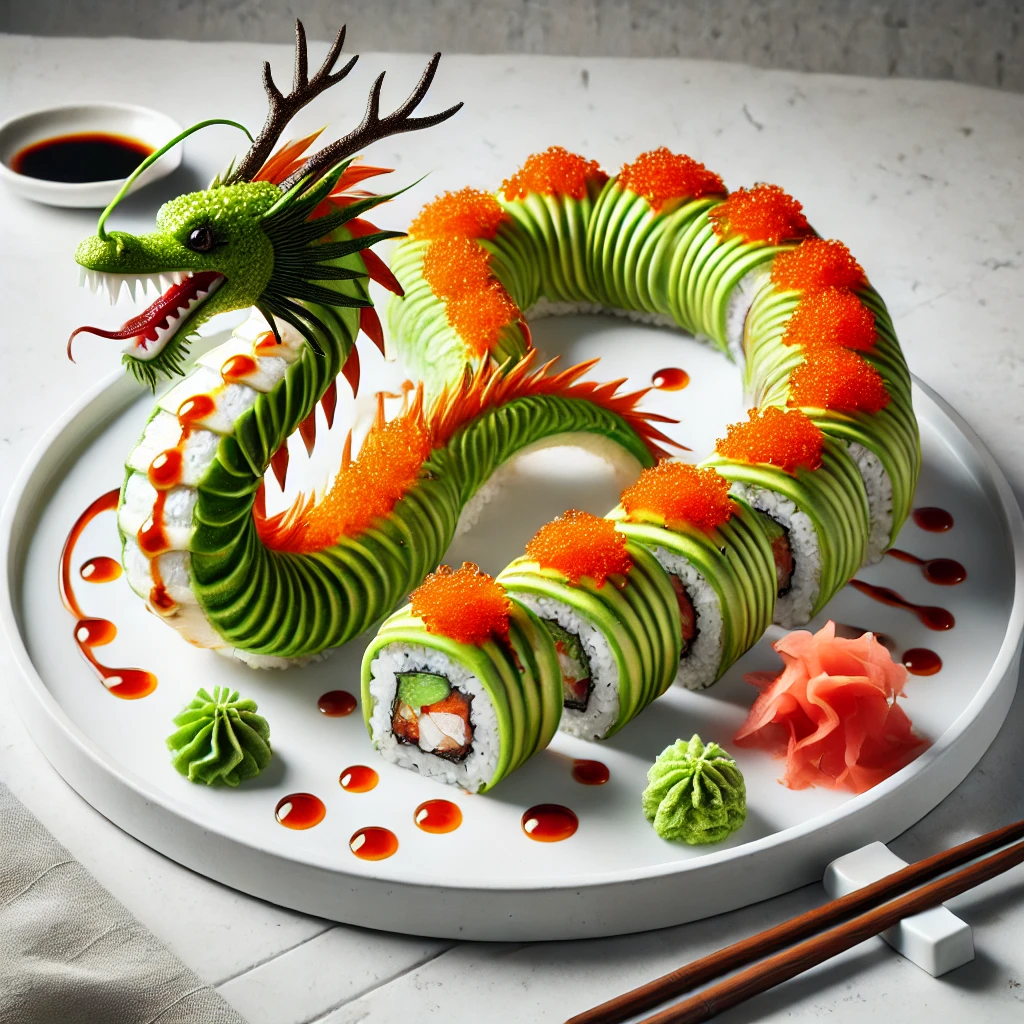Sushi lovers know that a great roll is more than just raw fish and rice; it’s about the fusion of flavors, textures, and presentation. One sushi creation that perfectly captures this idea is the Dragon Roll. With its vibrant colors and a mix of crunchy, creamy, and savory elements, the Dragon Roll is a sushi masterpiece that has become a favorite on sushi menus worldwide.
In this blog post, we’ll explore the history and concept of the Dragon Roll, dive into the unique ingredients that make it so special, and walk you through how to make this visually stunning and delicious roll at home. Whether you’re a sushi aficionado or a home chef looking to try something new, the Dragon Roll will impress both your eyes and your taste buds.
The History and Inspiration Behind the Dragon Roll
The Dragon Roll is a type of maki (rolled sushi) that is part of the growing trend of American-style sushi. It’s widely believed that Dragon Rolls first appeared in sushi restaurants in the United States, where chefs were eager to experiment with creative combinations of flavors and textures. Unlike traditional Japanese sushi, which tends to be more minimalist and focused on raw fish, American-style sushi rolls often incorporate cooked elements, sauces, and bold flavors.
The Dragon Roll gets its name not just from its ingredients but from its visual appeal. When sliced and arranged on a plate, the roll resembles the long, winding body of a dragon, with vibrant avocado slices mimicking the dragon’s scales. Often garnished with roe or a special sauce to resemble dragon “spines” or “claws,” this sushi roll is a feast for the eyes and the palate.
What Makes the Dragon Roll So Popular?
The Dragon Roll is beloved for many reasons, but a few key factors stand out:
1. Vibrant Presentation
The first thing you notice about a Dragon Roll is its striking visual appeal. The bright green avocado slices on top give the roll its “dragon” appearance, while the other colorful ingredients, like orange tobiko (fish roe) or the deep pink of eel or shrimp, add to its allure. This is a roll that looks as good as it tastes, making it a popular choice for sushi lovers who appreciate both flavor and presentation.
2. Perfect Balance of Texture
One of the reasons why Dragon Rolls are so satisfying is their textural contrast. The roll typically combines soft, creamy avocado with crispy tempura shrimp or crunchy cucumber. The juxtaposition of these textures elevates the eating experience, offering a delightful crunch followed by the smoothness of avocado and rice.
3. Flavor Fusion
Dragon Rolls are known for their rich, layered flavors. The combination of tender eel (unagi) or shrimp tempura with the creaminess of avocado and the sweetness of eel sauce creates a dynamic and complex flavor profile. Spicy mayo or wasabi can also be added to bring a touch of heat, making this roll a well-rounded fusion of savory, sweet, spicy, and umami flavors.
Essential Ingredients for the Dragon Roll
Before we dive into the recipe, let’s take a look at the key ingredients that make the Dragon Roll such a unique and flavorful dish.
For the Roll:
- Sushi rice: Short-grain sushi rice seasoned with rice vinegar, sugar, and salt.
- Nori (seaweed): Thin sheets of seaweed used to hold the roll together.
- Tempura shrimp: Lightly battered and fried shrimp that gives the roll its crunch.
- Avocado: Thinly sliced and placed on top of the roll to resemble dragon scales.
- Cucumber: Adds a refreshing crunch to balance the rich flavors.
- Unagi (eel) or eel sauce: Grilled eel or simply a drizzle of eel sauce adds sweet, umami-rich flavor.
For Garnishing:
- Tobiko or masago: These tiny fish eggs add a burst of texture and a pop of color to the dish.
- Spicy mayo: A mix of mayonnaise and Sriracha sauce for those who like a bit of heat.
- Eel sauce: A thick, sweet soy-based sauce that’s drizzled over the top of the roll.
How to Make Dragon Roll Sushi at Home: Step-by-Step Guide
Making Dragon Rolls at home may seem intimidating at first, but with the right ingredients and some patience, you can create a restaurant-quality roll that will impress everyone at your table. Here’s how to make it:
1. Prepare the Sushi Rice
- Rinse the rice: Start by rinsing 2 cups of short-grain sushi rice under cold water until the water runs clear. This removes excess starch.
- Cook the rice: Use a rice cooker or stovetop method to cook the rice according to the package instructions.
- Season the rice: Once cooked, mix the rice with a seasoning made from 1/4 cup rice vinegar, 2 tablespoons sugar, and 1 teaspoon salt. Let the rice cool to room temperature before using.
2. Fry the Tempura Shrimp
- Prepare the shrimp: Peel and devein the shrimp, leaving the tails intact.
- Make the batter: Mix 1 cup of flour, 1 egg, and 1 cup of ice-cold water to create a tempura batter.
- Fry the shrimp: Heat oil in a deep pan to 350°F (175°C). Dip the shrimp into the tempura batter and fry them for 2-3 minutes until golden and crispy. Set them on a paper towel to drain excess oil.
3. Assemble the Roll
- Lay out the nori: Place a sheet of nori (seaweed) shiny side down on a bamboo sushi mat covered with plastic wrap.
- Add the rice: Wet your hands to prevent sticking, then evenly spread a layer of sushi rice over the nori.
- Add fillings: Place the tempura shrimp and cucumber horizontally in the center of the rice-covered nori.
- Roll it up: Gently roll the sushi mat, keeping the roll tight as you go. Apply light pressure to ensure it holds together.
4. Create the Dragon “Scales”
- Slice the avocado: Use a sharp knife to thinly slice half an avocado into long, even strips.
- Top the roll: Place the avocado slices on top of the sushi roll, fanning them out to resemble dragon scales.
- Slice the roll: Using a sharp, damp knife, carefully slice the roll into bite-sized pieces.
5. Garnish and Serve
- Add the final touches: Drizzle eel sauce over the top of the roll and garnish with tobiko or masago. If you like heat, add a drizzle of spicy mayo as well.
- Serve: Arrange the pieces on a plate in a long, winding pattern to mimic a dragon’s body. For extra flair, use small bits of eel or cucumber to create dragon “claws” or “horns.”
Creative Variations of the Dragon Roll
Once you’ve mastered the basic Dragon Roll, there’s plenty of room for creativity. Here are some variations to inspire you:
1. Spicy Dragon Roll
For those who love heat, try adding some spicy tuna or spicy mayo inside the roll, along with the tempura shrimp. The added spice will give the roll a fiery kick while still maintaining its balance.
2. Rainbow Dragon Roll
To make this roll even more visually stunning, top the roll with thin slices of assorted fish like tuna, salmon, or yellowtail, in addition to the avocado. This colorful presentation adds both flavor and flair.
3. Vegan Dragon Roll
For a plant-based version, replace the tempura shrimp with tempura-fried sweet potato or tofu. You can still use avocado and cucumber for the filling, and top it with sliced avocado and vegan eel sauce.
Serving Suggestions and Pairings
Dragon Rolls are a show-stopper on their own, but they pair beautifully with other sushi dishes and accompaniments. Consider serving them alongside:
- Miso soup: A warm and comforting starter to balance the cool sushi.
- Edamame: Steamed and lightly salted soybeans are a classic sushi side dish.
- Seaweed salad: A light, tangy salad that adds freshness to the meal.
For drinks, sake, green tea, or a crisp white wine like Riesling or Sauvignon Blanc make excellent pairings.
Conclusion: The Dragon Roll is a Sushi Masterpiece
Whether you’re making it at home or enjoying it at your favorite sushi spot, the Dragon Roll is a sushi experience that goes beyond just a meal—it’s an artistic presentation, a symphony of textures, and a fusion of rich, balanced flavors. With its stunning appearance and delicious mix of creamy, crunchy, and savory elements, the Dragon Roll has earned its place as one of the most popular sushi rolls worldwide.
So, the next time you’re in the mood for sushi, why not give the Dragon Roll a try? It’s sure to leave a lasting impression on both your taste buds and your eyes.






